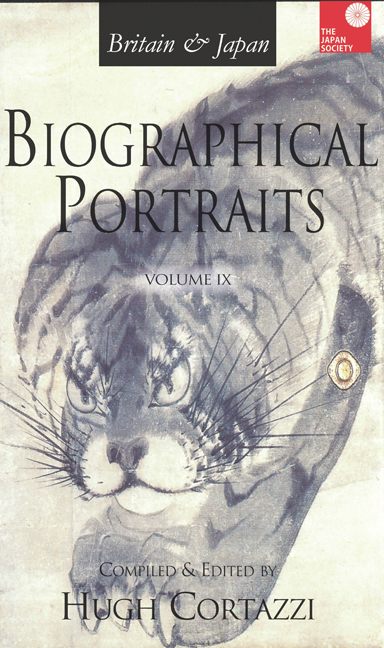Book contents
- Frontmatter
- Contents
- Introduction
- List of Contributors
- Index of Biographical Portraits in Japan Society Volumes
- PART I JAPAN IN BRITAIN: THINGS JAPANESE
- PART II BRITAIN IN JAPAN: TRADE
- BRITISH ACTIVITIES
- MISSIONARIES
- MUSIC, DRAMA AND FILM
- EPISODE
- PAINTERS
- JOURNALISTS
- JAPANESE WOMEN PIONEERS
- PART III SCHOLARS AND WRITERS: JAPANESE
- BRITISH
- PART IV POLITICIANS AND OFFICIALS: JAPANESE
- BRITISH OFFICERS
- BRITISH JUDGES AND A DIPLOMAT
- BRITISH POLITICAL FIGURES
- Index
24 - Ella Du Cane (1874-1943): Watercolourist
Published online by Cambridge University Press: 30 April 2022
- Frontmatter
- Contents
- Introduction
- List of Contributors
- Index of Biographical Portraits in Japan Society Volumes
- PART I JAPAN IN BRITAIN: THINGS JAPANESE
- PART II BRITAIN IN JAPAN: TRADE
- BRITISH ACTIVITIES
- MISSIONARIES
- MUSIC, DRAMA AND FILM
- EPISODE
- PAINTERS
- JOURNALISTS
- JAPANESE WOMEN PIONEERS
- PART III SCHOLARS AND WRITERS: JAPANESE
- BRITISH
- PART IV POLITICIANS AND OFFICIALS: JAPANESE
- BRITISH OFFICERS
- BRITISH JUDGES AND A DIPLOMAT
- BRITISH POLITICAL FIGURES
- Index
Summary
INTRODUCTION
ELLA MARY DU Cane was a watercolourist, most notably of flowers and gardens. Many of her paintings were used to illustrate the pages of A & C Black's popular colour books, with text often written by her sister Florence. In particular, Ella was admired for her depiction of Japanese flowers and gardens, which she painted with great exuberance. She was an inspiration to others at a time when Japanese gardens were very fashionable in the West, and when not many westerners had actually been to Japan. She helped to popularize the Japanese garden, introducing it to a wider audience.
She was born in Hobart, Tasmania, the third daughter of politician and then-Governor of Tasmania, Sir Charles Du Cane. Soon after she was born the Du Cane family returned to England, where Ella grew up in Braxted Park, Essex, the family estate.
Ella's mother was Georgiana Susan Copley, daughter of Lord Lyndhurst (1772–1863), three times Lord Chancellor under Prime Ministers George Canning, the Viscount Goderich, the Duke of Wellington and Sir Robert Peel. Her maternal great grandfather was the American portraitist John Singleton Copley (1738–1815).
She had no formal training as a painter, apart from ‘a few lessons in drawing and perspective’ from her governess, and one or two lessons from the painter Sir James Linton (1840–1916), but her talent, and knowledge of, and enthusiasm for, gardens, together with her family connections, brought private commissions and invitations to visit the rich and titled, and with it came commercial success.
EARLY CAREER
The Royal Family were early admirers, particularly Queen Victoria and the Prince of Wales. Between 1895 and 1898 the Queen herself commissioned and purchased no fewer than twenty-six watercolours, including paintings of the gardens at Windsor, Frogmore and Osborne. Several views of Osborne were given to the Empress Frederick (Victoria's eldest daughter), the Queen referring to Ella as ‘a very talented young Lady’. Both the Queen and the Prince of Wales visited her exhibitions at Graves’ Galleries in Pall Mall, and later, when the Prince was king (Edward VII), he continued to purchase a number of paintings himself.
Ella first exhibited at the Annual Exhibition of the Royal Institute of Painters in Water Colours in 1893, and appeared at regular intervals at the Graves’ Galleries, the Fine Art Society, and the Modern Gallery.
- Type
- Chapter
- Information
- Britain & Japan Biographical Portraits Vol IX , pp. 277 - 283Publisher: Amsterdam University PressPrint publication year: 2015



